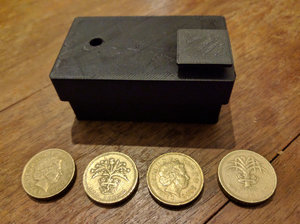Making of Microbutton
More technical details of how the MicroButton works.

Firmware
The ESP8266 development board is running the wonderful Micro Python. As a general overview, the board sleeps in low power mode until the reset button is pressed. Then connects to the wifi network using values stored in config_mc.py, then do http_get(config_mc.resetURL) and machine.deepsleep(), sleeping the board in low power mode until the reset button is pressed. https://github.com/bmsleight/shedcode/blob/master/microbutton/main.py
# Micro Python
do_connect(config_mc.ssid, config_mc.passwd)
http_get(config_mc.resetURL)
machine.deepsleep()
Much more tricks are used to make the configuration simple. Normally Micro Python boots and set-ups a webconsole. http://docs.micropython.org/en/latest/esp8266/esp8266/general.html#boot-process I have changed this to run a mini webserver https://github.com/bmsleight/shedcode/blob/master/microbutton/inisetup.py
Fun Webserver in Micro Python
Micro Python on the ESP8266 does not include urlencode. So extracting a string like http%3A%2F%2Fbarwap.com%2F%3Fencoded from a response on the very basic webserver is hard. However JSON encoding and decoding is possible. All I have to do is send JSON back to the webserver.
We set the ESP8266 development board to be an access point, so no jquery - src="https://code.jquery.com/jquery-3.1.1.slim.min.js" and simple webserver only accepts a 4096 bytes. The other example server did not accept Content-Type:application/json very well.
So what can we do with a few bytes. We split the four inputs (SSID, Passwd, resetURL & poweroffURL) and send them one at a time, given all the other padding, allowing a whopping 85 per field. Also, after every set - we just reply with a name of the next field, no reloading of the full page - took much of a hack to call it a full RESTful interface. On the last response we just hide the set button. Last of all remove much of the white space indenting to get a final squeeze.
<script>
function sV() {
var v=document.getElementById('v').value;
var k=document.getElementById('k').value;
var obj ={};
obj[k] =v;
var j=JSON.stringify(obj);
var x=new XMLHttpRequest();
x.open("POST", "/");
x.setRequestHeader('Content-Type', 'application/json; charset=UTF-8');
x.send(j);
x.onloadend = function () {
var r=(x.responseText);
if ( r == "D" ) {
document.getElementById("s").style.visibility = "hidden"
d = document.getElementById('l');
d.innerHTML = d.innerHTML + 'Set ' + j + '<br/>Done';
} else {
d = document.getElementById('l');
d.innerHTML = d.innerHTML + 'Set ' + j + '<br/>';
document.getElementById("n").innerHTML = r;
document.getElementById("v").value = "";
document.getElementById("k").value = r;
}
}
};
</script>